
Another family business that put its unique stamp upon the transport industry over some four generations, is Chris Miller of Preston. The company carried out all manner of transport tasks, often utilising the most unlikely equipment. As with Wynns, many of the early techniques and solutions to the job of loading and moving heavy loads, originated moving round timber from local forests, where necessity is the true mother of invention. We look back at Miller’s long history, the diverse equipment it used and a long list of its achievements that have stood the test of time.
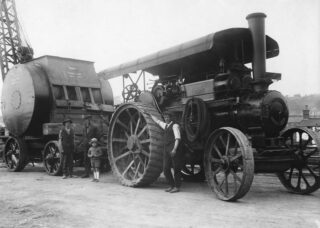
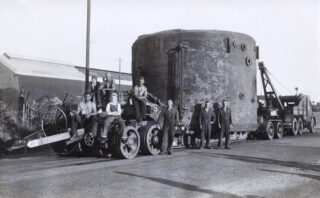
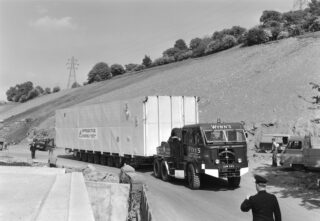
MEMBERS OF OUR INDUSTRY HAVE BEEN SADDENED BY THE DEATH OF JOHN WYNN, A DIRECTOR OF ROBERT WYNN AND SONS DURING THEIR GLORY DAYS, AND A TRUE LEGEND OF THE HEAVY HAULAGE BUSINESS. JON HARLE HAS BEEN LOOKING BACK ON HIS LIFE AND CAREER.
It was an agonising decision. It was 06.00hrs on Sunday 5 December 1971, and it was a cold dark morning at Cammell Laird in Birkenhead. Three huge vessels, that had been manufactured in Holland, had been shipped across and loaded onto three Wynns vehicles, ready for the 17-mile journey to the Shell oil refinery at Stanlow. And these loads really were huge. The biggest was 112 feet long, 25 feet in diameter, and weighed 212 tons, and would be the largest load to travel on UK roads. The two others were only slightly smaller. Six ballasted tractors and their crews were standing by to pull and push them, along with about 30 police motorcycle escort riders. Due to the size of the loads, three footbridges had been lifted aside, and about 200 items of street furniture, including traffic lights and keep-left bollards, had been removed. Power lines and telephone wires had been switched off, and hundreds of people were waiting to watch the record-breaking move.
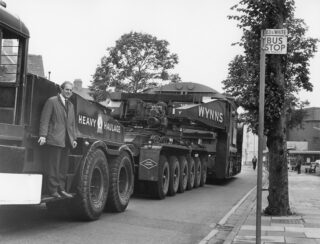
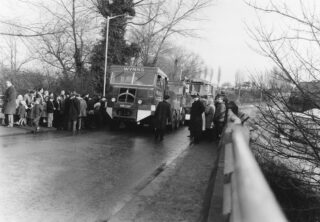
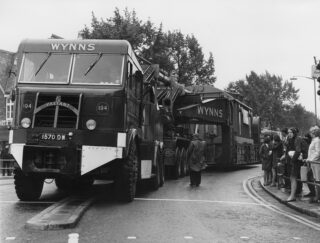
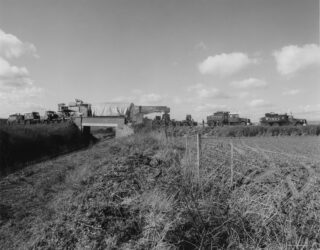
AS PART OF HEAVYTORQUE’S TRIBUTE TO THE LIFE AND WORK OF JOHN WYNN, WE LOOK BACK TO A PROJECT THAT WAS FEATURED PREVIOUSLY IN THE MAGAZINE. WE FEEL THAT IT PERFECTLY DEMONSTRATES JOHN’S HANDS-ON APPROACH TO HEAVY TRANSPORT OPERATIONS AND HIS FAMILY’S CONTRIBUTION TO MANY OF THE LARGE INFRASTRUCTURE PROJECTS IN THE UK AT THE TIME.
Three decades ago, the UK and French governments were close to a new Entente Cordiale. The previous year, 1984, both had agreed to invite private developers to submit proposals – to construct and operate a fixed cross-Channel link. Provided it could be done without any public money.
That historic pact green-lit the eventual £4.65bn Tunnel, opened in 1994, now carrying 50,000 passengers and 54,000t of freight a day. Yet readers, whose memories stretch a little further back than 1984, may recall a previous attempt 10 years earlier to connect France and Britain. That began in November 1973: the two countries signed a treaty, intending to finance the undersea project with government-guaranteed loans. But, just over a year later, the scheme was abandoned when the UK’s new Labour government pulled out, claiming it no longer wanted to finance the project.
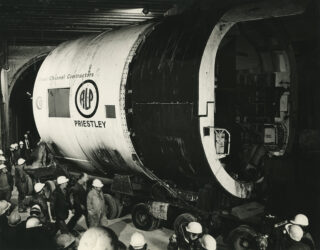
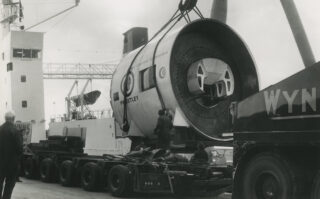
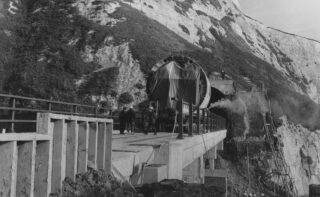
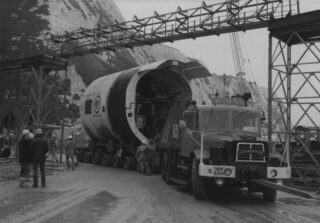
Issue Twenty Three: with 164 pages of first-class journalism and photography, what more can you wish for? In short, this issue is dedicated to the life and times of Mr John Wynn. Click the appropriate link below to purchase your annual subscription, or individual copy.
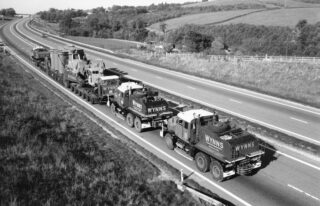
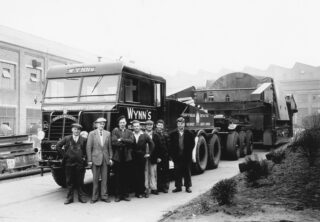
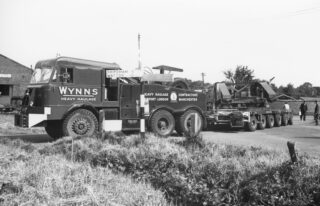
THE RECENT PASSING OF JOHN WYNN IS A VERY SAD TIME FOR FAMILY AND FRIENDS, IT’S ALSO ALMOST THE END OF AN ERA IN THE LONG HISTORY OF SPECIALIST HEAVY TRANSPORT. BOB BEECH GIVES HIS OWN TRIBUTE.
John Wynn had enjoyed a long and busy retirement, writing a number of books, creating numerous DVD’s and giving talks and lectures to many groups and organisations, detailing the long and fascinating history of his family’s transport business. His life-long involvement in heavy transport, meant that he was a direct link to industry pioneers who worked with both steam engines and horses in the early part of the last century. John’s great guide and mentor, his uncle HP (Henry Percy) Wynn, was an individual with the vision and foresight to create and develop equipment and techniques that are still at the core of the modern heavy transport industry.
HP served an apprenticeship building steam traction engines, with Fowlers at Leeds, actually building Wynns’ last new steam traction engine, before starting work for the family company in 1923. The company was a very early user of steam engines and it gradually took over from horses as the key means of shifting heavy loads, in time diesel took over from steam.
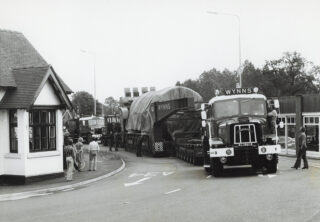
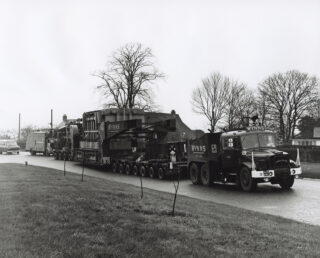
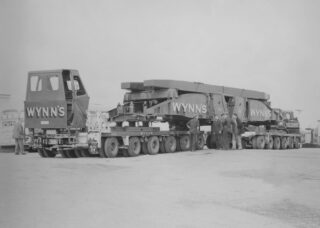
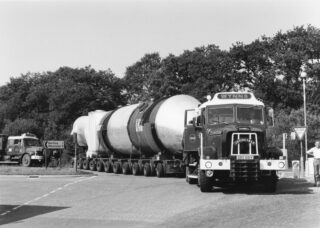
THE CONTINUOUS DEVELOPMENT IN TRAILER MODERN TECHNOLOGY IS AT THE HEART OF THE MODERN HEAVY TRANSPORT INDUSTRY. MANY OF THESE BASIC CONCEPTS WERE DEVELOPED BY CLOSE COOPERATION BETWEEN OPERATORS AND MANUFACTURERS, AT ONE TIME BRITAIN LED THE WORLD IN THIS PROCESS, NONE MORE SO THAN WYNNS HEAVY HAULAGE UNDER THE STEWARDSHIP OF PERCY (HP) WYNN AND HIS NEPHEW JOHN.
Heavy haulage can easily be perceived as a romantic business, and one that is full of tales of ‘derring-do’. But it’s all too easy to be seduced by the charisma and romance of the tractor when the truth is that heavy haulage is as much about the trailer as its prime mover. After all, the tractor simply provides sufficient grunt to actually move the load, whereas the trailer has to be capable of holding the load securely in place during the move, supporting the load’s weight – a weight that’s often very considerable – and providing the steersman with facilities required to hep the tractor guide the load into position without incident.
In the early days of the business, a trailer was really nothing more than a platform on wheels. In the 1920’s, for example, even the heaviest loads were carried on nothing more sophisticated than an extensible trailer running on a pair of solid-tyred axles, or a low-loader semi-trailer, again generally shod with solid tyres.
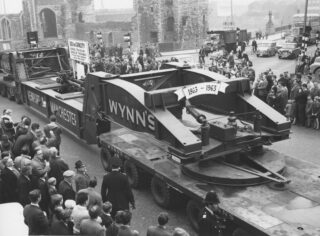
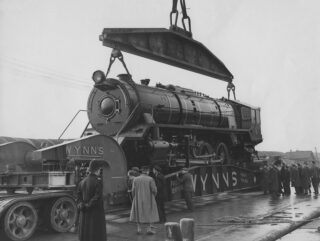
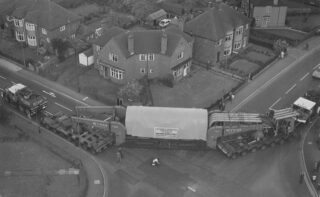
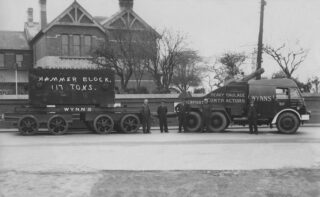
Issue Twenty Three: with 164 pages of first-class journalism and photography, what more can you wish for? An issue almost completely dedicated to the life and times of Mr John Wynn. Click the appropriate link below to purchase your annual subscription, or individual copy.
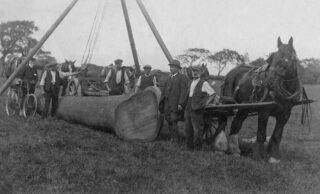
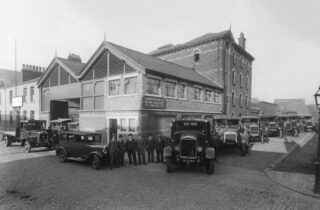
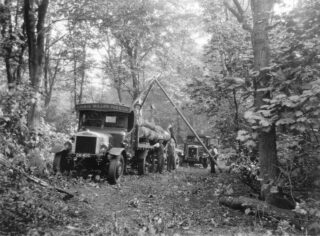
AFTER DECADES OF USING TRADITIONAL METHODS TO MOVE AWKWARD LOADS, CHRIS MILLER OF PRESTON EARNED A REPUTATION FOR DOING WHAT OTHER OPERATORS SAID COULDN’T BE DONE. HEAVYTORQUE HAS BEEN TALKING TO CHRIS MILLER JUNIOR, SON OF THE COMPANY’S LAST BOSS.
There can’t be many ordinary people who’ve celebrated their 70th birthday with a big family gathering deep underground in the heart of a Welsh mountain! But Chris Miller of Preston was no ordinary man. He was the last managing director of the heavy haulage company first established by his great, great grandfather, also called Chris, more than 170 years earlier. The biggest challenge of his career was in the late 1970s, when he organised the delivery of six massive sets of hydro-electric equipment to Dinorwig Power Station, which was under construction deep inside Elidir Fawr in North Wales. He’d always threatened to take his family there, to what the locals call ‘Electric Mountain’, to show them where he’d had to spend four intense years of his working life, and that’s why he chose the power station in Snowdonia as the venue for his special birthday 10 years ago!
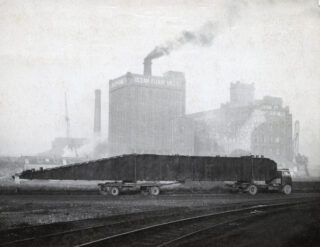
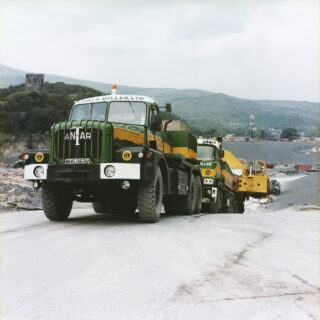
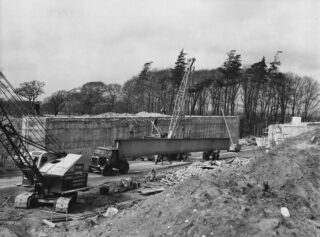

HALLETT SILBERMANN’S JON HUGILL IS ABOUT TO RETIRE AFTER NEARLY HALF A CENTURY IN THE HEAVY HAULAGE BUSINESS. HE’S BEEN LOOKING BACK OVER HIS CAREER WITH HEAVYTORQUE.
As a youngster walking home from school in the 1960s, Jon Hugill used to love watching the big lorries trundling down Southbury Road in Enfield in North London. But as he watched the Scammells, Atkinsons, Bedfords and AECs grinding their way towards the docks, he never thought that one day he’d follow a career in road haulage himself. When he left school, he was more interested in getting a job as a carpenter or a draughtsman, but he had no luck in securing an apprenticeship.
Then fate stepped in. Or rather, Hugill’s mother did. She spotted an advert in the local paper for a trainee traffic operator to work at the Enfield branch of Pickfords Heavy Haulage, not far from where they lived. “I remember walking home from that interview in 1973,” Hugill recalls, “and thinking ‘what was that all about?’ and wondering what job I should apply for next. I was quite surprised to get a letter offering me the position! But even though I’d had no background in transport, let alone heavy haulage, I found I quickly fell in love with the business. Pickfords was a fantastic company for training and supporting staff, and one of the first things I learned was that pretty well anything was possible.
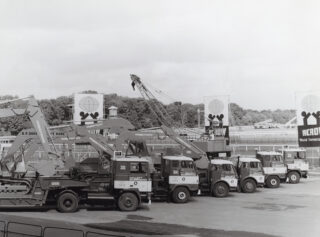
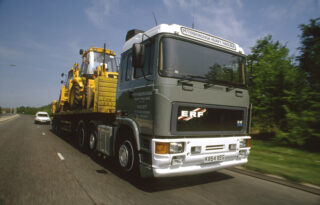

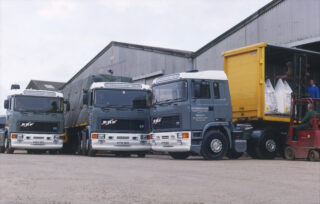
Issue Twenty Three: with 164 pages of first-class journalism and photography, what more can you wish for? In short, this issue is dedicated to the life and times of Mr John Wynn. Click the appropriate link below to purchase your annual subscription, or individual copy.
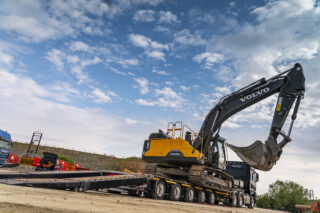
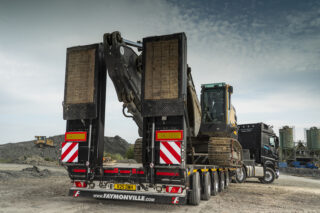
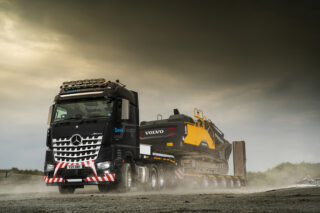
IF YOU’VE ONLY GOT ONE VEHICLE AND YOUR WHOLE BUSINESS DEPENDS ON IT, IT’S IMPORTANT TO HAVE THE RIGHT TOOL FOR THE JOB. HAPPILY, PLANT HIRE AND EARTHMOVING SPECIALIST DEREK W HANCOX HAS REALLY LANDED ON ITS FEET WITH ITS LATEST LOW-LOADER COMBINATION. HEAVYTORQUE FINDS OUT MORE..
Every cloud has a silver lining, they say. When Derek Hancox was made redundant after 12 years in a production engineering job at Rank Xerox back in the early 1980s, it led to him setting up for himself as Cinderford, Gloucestershire-based plant hire and earthmoving specialist, Derek W Hancox – and he hasn’t looked back since.
Now in his 70s, Hancox still works as the firm’s MD, backed up by son Shaun, who is the plant manager, daughter Michelle, who handles the administration and compliance, and son-in-law Sean Quinn, who is the firm’s transport manager.
“I had a sound engineering background, after an apprenticeship with diesel engine manufacturer R A Lister and a stint as a service engineer for Muir Hill, working with their loading shovels and dumpers. And at Rank Xerox, I was on the toolmaking side,” says Hancox.
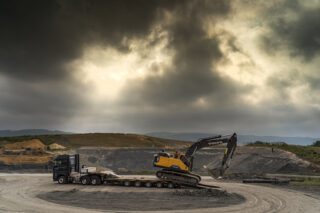

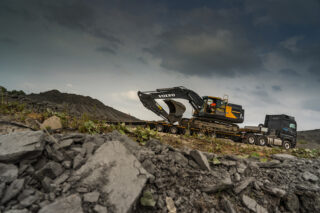
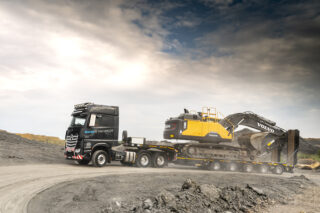
LONDON IS TIGHTENING UP SAFETY ON ITS ROADS WITH A NEW PERMIT SCHEME THAT WILL AFFECT OPERATORS RUNNING HGVS OVER 12-TONNES. SO WHAT DO YOU NEED TO DO TO COMPLY? HEAVYTORQUE FINDS OUT.
The Direct Vision Standard (DVS) has been described as the first legislation of its kind and is designed to keep the streets of London safer for pedestrians and cyclists. However, it is the operators of heavy vehicles that are affected by the standard, introducing a permit system that assigns vehicles a star rating based on how much the driver can see through their cab window. Transport for London (TfL) says its implementation is in response to the number of accidents in the Capital involving HGVs: official statistics show that trucks in London are involved in 63 per cent of fatal collisions with cyclists and 25 per cent of fatal collisions with pedestrians. As a result, the DVS was originally scheduled to be enforced from October 2020, but the arrival of the Covid-19 pandemic forced TfL – tasked with enforcing the standard – to temporarily delay it by four months.
Despite a growing number of voices in the industry calling on DfT to suspend the DVS for much longer, possibly by up to a year, its eventual rollout is inevitable and it’s therefore important that heavy vehicle operators understand what it is and how they should comply.




Issue Twenty Three: with 164 pages of first-class journalism and photography, what more can you wish for? In short, this issue is dedicated to the life and times of Mr John Wynn. Click the appropriate link below to purchase your annual subscription, or individual copy.